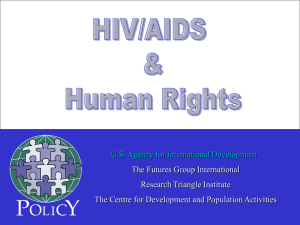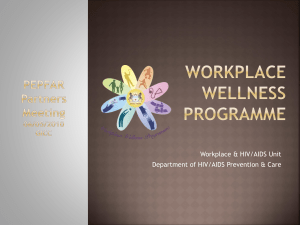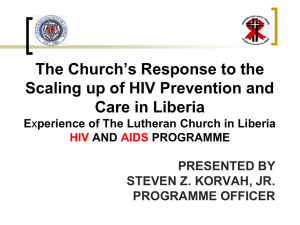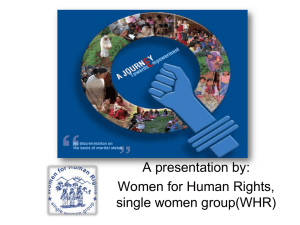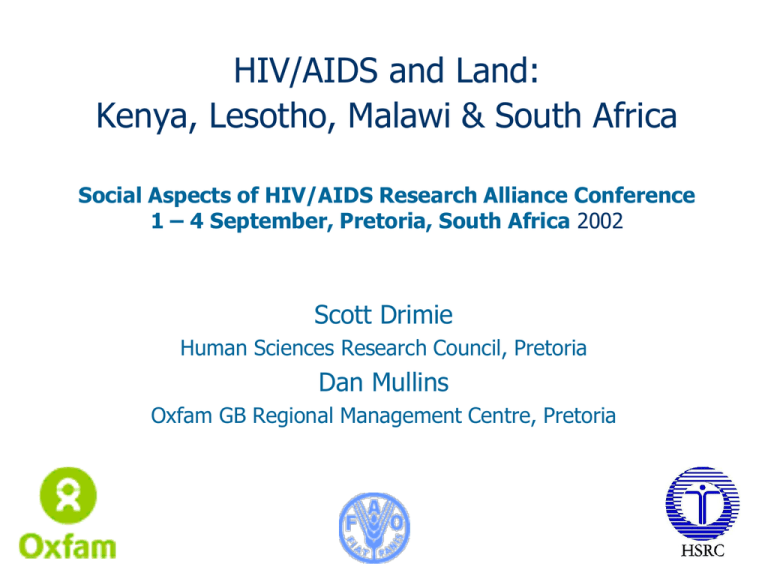
HIV/AIDS and Land:
Kenya, Lesotho, Malawi & South Africa
Social Aspects of HIV/AIDS Research Alliance Conference
1 – 4 September, Pretoria, South Africa 2002
Scott Drimie
Human Sciences Research Council, Pretoria
Dan Mullins
Oxfam GB Regional Management Centre, Pretoria
Background to the Study
Empirical data on links between land and AIDS
• FAO: Kenya, Lesotho, South Africa
• HSRC: coordination; South Africa
• Oxfam GB: Malawi
“If we do not explicitly factor in the impacts and trends
of HIV/AIDS as a central feature of how to do land
reform . . . We are being professionally negligent,
misusing resources for poverty reduction, and are
unlikely to achieved our objectives.”
Land policy encompasses
three main dimensions
• Land use
• Land rights
• Land administration
Two-Way Influence: HIV/AIDS and Land
HIV transmission, progression to
AIDS, impacts of AIDS
Land use, land rights, and land
administration
HIV/AIDS and Land: Profound
Challenge
Management challenge for those involved in land
reform and rural development
Affects both:
• people whom land policy is intended to benefit
• people staffing the institutions that support the policy
implementation
The effect of HIV/AIDS on
households/livelihood strategies
Household with
weaker safety
net
Household
with stronger
safety net
Vulnerability
line
Early stages
Frequent Bed ridden Death and
hospital visits
burial
Care for
orphans
Findings from the Studies
Impacts on Land Use
Change land use
• Lower productivity
• Less labour intensive uses
• Leave land fallow
Different users
•
•
•
•
In the home: shift to young, elderly, widows
Rent or lease out land
Enter into sharecropping or other contractual arrangements
Lend land to others
Lose land
• Sell land formally or informally
• Abandon land
• Others forcibly take land way – from widows, orphans
Impacts on Land Use: Examples
• Gender and age: key influences everywhere
• Most sites: reduced agricultural yields
– Reduced labour due to illness, shift to increased caring
demands
– Sale of productive assets: seeds, cattle
– Responsibility shifts to young and old
– Less experience and skills
multi-generational impacts
• Changing amounts of land under use ?
– Kenya: significant reduction in cultivated land
but
– Southern Malawi: high density, so land taken by new users
Land Use affects HIV/AIDS
Weakened livelihoods increase risks of HIV/AIDS
– new HIV transmission: women and girls engaging in sex work
– poverty and poor nutrition speed progress from HIV to AIDS
Poverty, Inequality,
Crisis
New HIV Infection;
Rapid Progression
from HIV to AIDS
Food
Insecurity
Malnutrition
Impacts on Land Rights
Vulnerable people under increased pressure
• Gender and age: both affect ability to enjoy rights
Affects ability of widows, orphans, youth & children to:
• Access: participation in land reform / resettlement
• Use: for homestead, burial grounds, livelihoods activities
• Transact: inheritance by children, renting out by widows etc
• Exclude others: land grabbing and inheritance, control over
decision-making (power taken by older people, especially men)
• Enforcement: legal and administrative system may not protect
Impacts on Land Rights: Examples
Land-grabbing from widows in general: common but usually
illegal
Widows in KwaZulu Natal: increasingly resisted pressure to either
relinquish their land or marry back into the husband's family
Affected HHs in Lesotho: customary & formal law differ on fallow
land
•
•
Some chiefs allow affected households to retain fallow land for future
Formal law seeks to keep land productive
Children in Kenya: most affected through dispossession by
‘guardians’
Youth-headed HHs in South Africa: vulnerable, not qualified to
hold communal land
Impacts on Land Administration
Increasing illness & death of extension and land officials
• Productivity declines:
– staff absenteeism, illness, low morale,
– growing inefficiency
• Human resources affected:
– staff turnover, increasing competition for new staff, multiple
recruitments
– declining levels of experience and quality
• Financial costs increase:
– medical care, funerals, induction and training
– actual survival of some organisations in question
Impacts on Land Administration:
Examples
• Malawi: deaths of key personnel, recurrent illnesses of others
have increased absenteeism, decreased performance
• Kenya: illness and death of land officials and chiefs stalled
adjudication processes, and resulted in loss of institutional
memory
Current Land Policy Framework
All 4 countries are reviewing land policy
None are actively considering current and
future impacts of AIDS, on either:
– potential users
– implementing agencies
Recommendations
Put two-way links at centre of land policy and programmes:
HIV/AIDS land use, land rights, and land administration
Collaboration between land and HIV/AIDS specialists: build on
complementary skills to minimise HIV transmission and impacts
Understand heterogeneity: Seek to support diverse household types
that result from HIV/AIDS impacts – influences of gender and age
Galvanise research, policy and implementation: to understand links
between land and AIDS in a co-ordinated manner
Recommendations
Facilitate wider land use options: for both agricultural and
non-farm activities, to be relevant to particularly vulnerable
people (widows, orphans, youth and children, elderly); eg:
– develop land rental markets
– increase access to water for gardening purposes
Support rights of vulnerable people: Ensure needs of weaker
individuals and households (gender, age, social situation) are
addressed in land administration; eg land registration systems
Protect institutional capacity: Evaluate long-term capacity of
land administration systems in light of HIV/AIDS among staff


